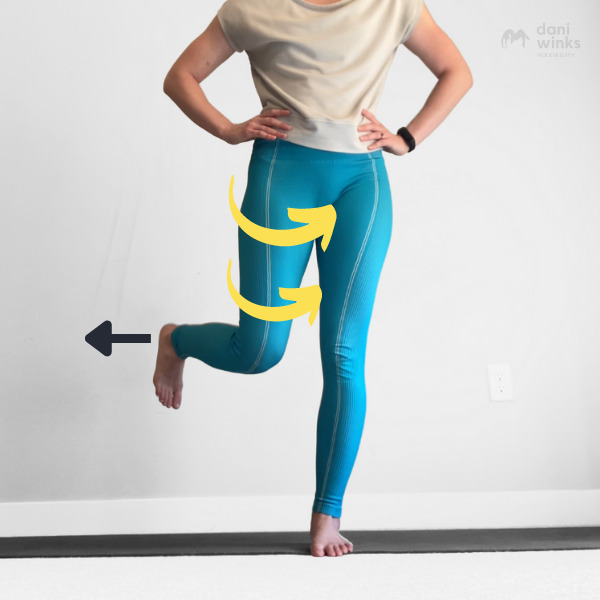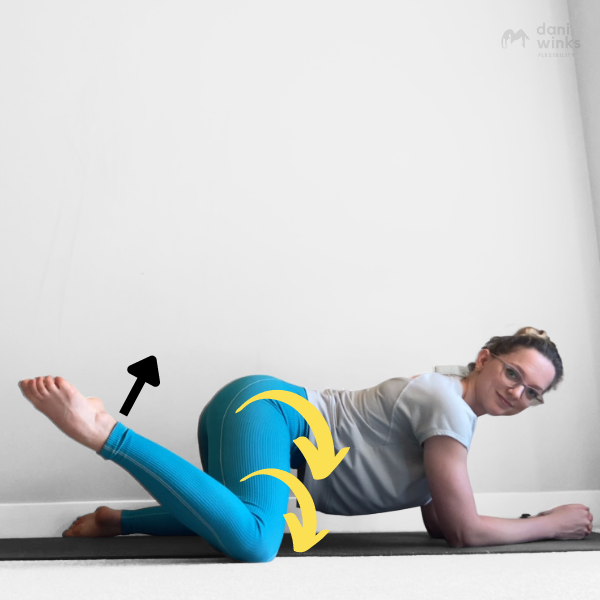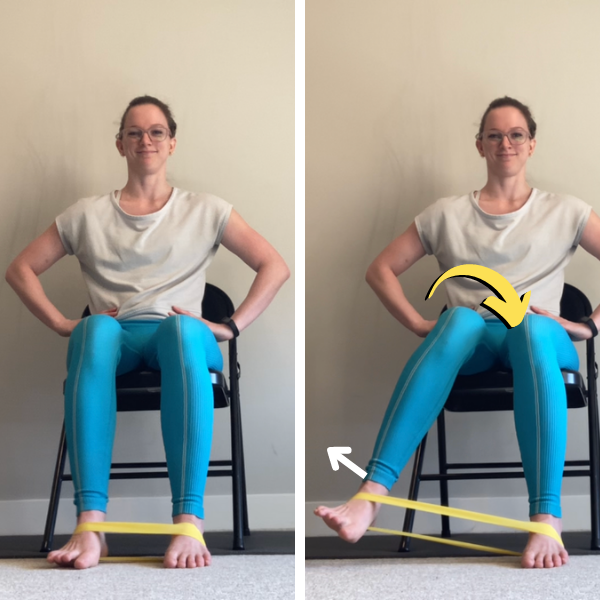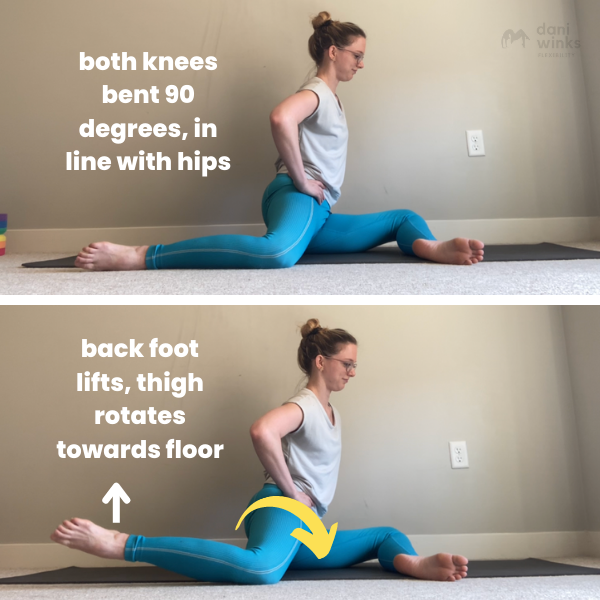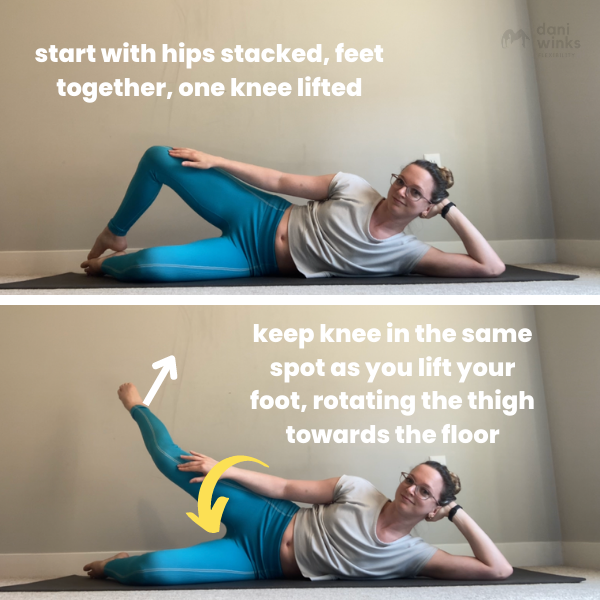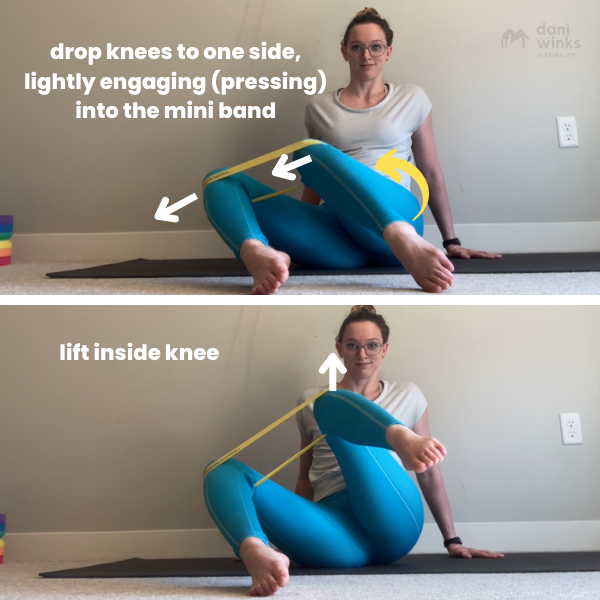Strengthen While You Stretch: 6 Drills for Active Hip Internal Rotation
Strengthen While You Stretch: 6 Drills for Active Hip Internal Rotation
Hip rotation in general is not only helpful for many stretches/skills, but a necessary part of everyday movements like walking and running. Internal hip rotation specifically refers to the action of rotating our thigh internally (towards our midline), and this can be combined with other hip actions like extension (kicking a leg behind you), flexion (hinging at the hips) or abduction (opening your leg out to the side):
Hip Internal Rotation
(in Hip Extension)
Hip Internal Rotation
(in Hip Flexion)
Hip Internal Rotation
(in Hip Flexion & Abduction)
You’ll notice few of those positions look like poses we typically go through in our everyday life - so it’s no wonder most people struggle with hip internal rotation flexibility and strength!
Why work on active internal hip rotation?
There are three main reasons we care about actively working on this admittedly funky range of motion:
To train our hip stabilizers to engage and support deeper ranges of motion (especially hip flexion - if you’re someone who struggles with forward folds and hamstring stretches, it may be helpful to work on strengthening your internal hip rotation while in hip flexion)
If you’ve been told by a physical therapist or physio that you lack sufficient range of motion (ROM) in your internal rotation and it’s impacting your everyday hip movements (ex. walking) or causing related pain (ex. low back pain)
If you need additional ROM for skillwork in your particular movement discipline (ex. getting into a Libelula in pole dance, doing cool bent knee leg swoopy floorwork variations, or the crazy amount of internal rotation limbo dancers use when they drop their knees in towards each other when they limbo under a bar)
Often when we talk about hip mobility - the ability to move our hips/legs through a range of motion using our own muscles, we are referring to moving through our active (engaged) range of motion. So if hip mobility and being able to use your IR is a goal (which is likely the case), active flexibility drills where you actually strengthen your muscles are a must!
What’s a “normal” amount of hip internal rotation?
The research I’ve seen on this is a bit mixed. A “typical” passive range of motion for internal rotation (IR) is around 30-40 degrees (although I’ve seen other studies that have results closer to 50 degrees, so 45 degrees is a pretty good guestimate of a realistic “normal”). Active IR (meaning how far you can use your muscles to internally rotate your hip without assistance from your hands or a prop) is typically a bit smaller, around 35 degrees.
Anecdotally, I can confirm from teaching my own students that most people find external hip rotation (thigh rotating to the outside) a bit easier than internal hip rotation, and usually have a bit more range of motion in that direction. So if you find internal rotation to be a challenge, that’s pretty common!
6 Active Flex Drills for Internal Hip Rotation
1. Face Down Feet Opens
Lie belly-down on the ground like you’re a young George Michael Bluth who’s just been broken up with (that just means lie face down on the ground, legs about hip width apart). Place a yoga block on the skinniest width between your knees for support
Bend your knees 90 degrees so your feet point up towards the ceiling (feet can be pointed or flexed, doesn’t matter), and lift your knees off the ground (this should feel like a squeeze in your glutes!)
Keeping your knees hovering just above the floor, slowly splay your feet out to each side, rotating your thighs in towards each other. Let your feet fall as far apart as possible (so long as you don’t feel any pinching or pain).
Then close your feet back towards each other (thighs rotate towards the floor). That’s one rep
Repeat for 8-12 reps, trying to keep your knees lifted off of the floor the whole time
Need to make it easier? Don’t worry about the glute engagement, keep your knees on the ground the whole time
Want to make it harder? Add a light resistance band around your ankles, or light ankle weights
2. Seated Internal Hip Rotation with Band
Start sitting on a chair with both knees bent in front of the hips. Loop a light resistance mini band around the bottom of both of your feet
Keeping both knees in line with your hips (don’t let them squeeze in or splay out), lift one foot out to the side, rotating that thigh towards the other leg
Then bring that foot back to the floor (thigh to the ceiling). That’s one rep
Repeat for 8-12 reps on one leg, then switch legs
Need to make it easier? Place a yoga block between your knees to help your knees brace and keep your knees in place, and/or lose the strap and just go through this movement using your own bodyweight
Want to make it harder? Once you’ve internally rotated the thigh (foot to the outside), lift your knee up, then drop it back down, then bring your foot back to neutral
3. 90-90 Side Foot Lifts
Start seated in 90-90 or pinwheel stretch: sitting on the floor (or some yoga blocks), both knees bent 90 degrees, one knee directly in front of one hip with the shin splayed across your body (thigh rotated to the outside), the other knee directly outside the other hip (with the thigh rotated forwards). The “outside leg” is in internal hip rotation and that’s the leg we’ll be working on in this drill
Keeping your knees on the floor, try to lift the outside leg foot off the floor (rotating the thigh towards the ground), then drop the foot back down. It may barely lift at all - that’s OK!
Repeat for 8-12 foot lifts on one leg, then switch your pinwheel legs and do 8-12 reps on the other leg
Need to make it easier? Lift your hips higher, start sitting on one (or two) yoga blocks, and/or lean away from the working leg
Want to make it harder? After you’ve lifted your foot up, see if you can lift your knee (but try to keep the foot higher than the knee so you maintain the internal rotation), then lower back down
4. Reverse Clamshells
Start lying on your side with knees bent, knees under your hips (so the front of your hips are flat, not piked), and both hip bones facing forwards
Keeping your hips facing forwards (don’t let them shift) and toes touching, open your top knee towards the ceiling (opening your legs like a “clam shell”)
Keeping your top knee in the same spot in space, lift the top foot towards the ceiling (rotating your thigh towards the floor - this is the internal hip rotation), then drop the foot back towards the floor (rotating your thigh slightly towards the ceiling - external hip rotation)
Repeat for 8-12 reps
Need to make it easier? Only lift your top knee to hip height (so your thigh is parallel to the floor) instead of taking it all the way towards the ceiling
Want to make it harder? Add a mini loop (resistance band) around your lower thighs
5. Knee Block Crunches
Start sitting on the floor with your knees bent. Place on yoga block on the skinniest setting between your knees, and one yoga block on the widest setting between your feet (so your knees should be closer together than your feet). Lightly squeeze the blocks so you don’t drop them
Lean back onto your hands, or drop to your elbows. Pull your knees in towards your chest, lifting both yoga blocks, then lower your feet back down to the floor
Repeat for 8-12 crunches
Need to make it easier? Instead of just leaning back, lay all the way down on your back
Want to make it harder? Instead of holding a block between your feet, loop a mini band around your ankles and press your ankles out into the band (actively engaging to keep them pressing into the band the whole time
6. Banded Windshield Wipers + Knee Lift
Credit for this drill goes to the fabulous Dr. Jenn Crane (aka @cirque_physio) - I learned this in one of her Oh the Nerve! neurodynamic workshops. This is not only a helpful stabilizer for folks with sciatic nerve tension, but it can help our stabilizers get stronger for hip flexion in general (helping make forward folds, and really any hamstring stretch, more comfortable).
Start sitting on the floor with knees bent, feet on the ground about hip width apart in front of you, and a mini band looped around your knees
Keeping your toes on the floor in front of you, and knees slightly pushing out into the strap, flop both knees over to one side (the leg that’s on the bottom will be in external hip rotation, the leg that’s on top will be in internal hip rotation)
Lift the top knee up, pressing against the resistance of the mini band, then lower it back down bringing your toes to the floor
Flop both knees to the other side and repeat on the other leg (lift the knee for a moment, then drop it back down)
Repeat for 5-10 reps on each leg
Need to make it easier? Ignore the knee lift - just work on keeping your thighs engaged pushing into the strap as you “windshield wiper” your knees side-to-side
Want to make it harder? Once you’ve lifted your knee, kick your top leg straight for a moment. Then bend the knee and drop it back down
What About Passive Stretching?
Our active ROM can only ever be as good as (although usually it’s a bit worse than) our passive ROM. If you have a limited passive range of motion in your hips, then your active range of motion is going to be even more limited. On the flip side, if you have quite a lot of passive ROM (ex. more than 45 degrees) and you don’t functionally need more for your hobby/lifestyle, then you probably don’t need to worry so much about continuing to increase your passive ROM - instead keep working to narrow the gap between your maximum active ROM and your maximum passive ROM.
But if you’re passive internal rotation is quite far from where you want it to be, you’ll want to include passive stretching in your training regimen as well so you can spend more time in those deeper stretches. For recommended passive hip IR stretches, I’ll be posting a blog post on that very topic next Monday - so stay tuned!

